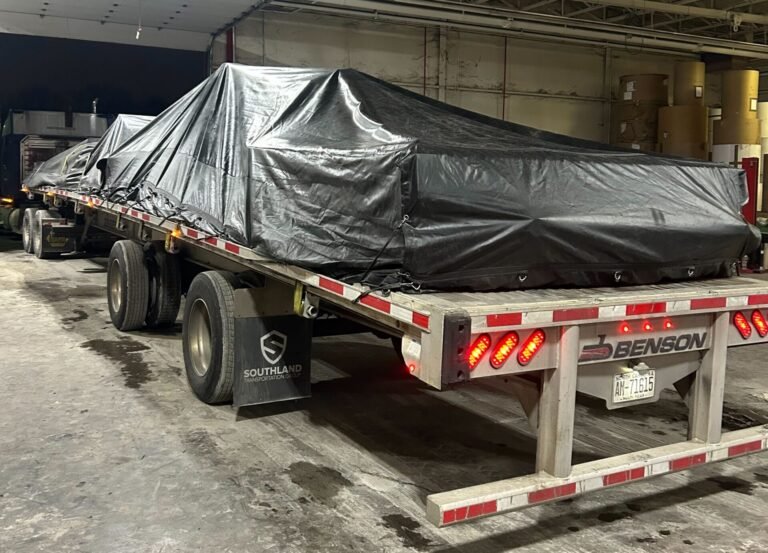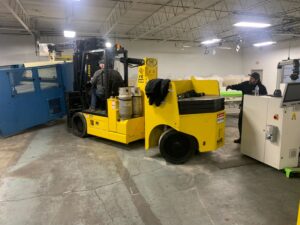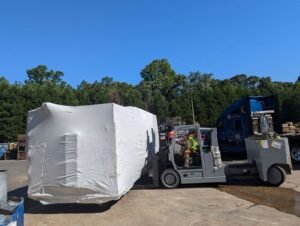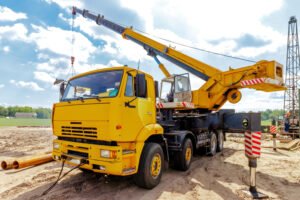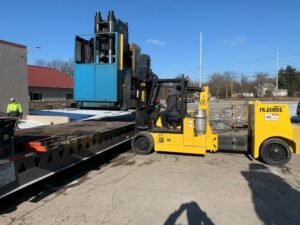Transporting heavy equipment is always a complex undertaking—but seasonal weather shifts introduce an entirely new layer of challenges. From snow-packed highways and thawing spring roads to extreme summer heat and stormy autumn weather, each season demands unique strategies to ensure safety, efficiency, and compliance.
This comprehensive guide explores the seasonal considerations in heavy equipment transport, breaking down how each season affects logistics, what precautions to take, and how to plan for uninterrupted, damage-free delivery year-round.
Winter – Navigating Ice, Snow, and Safety Risks
Transporting oversized and heavy equipment in winter brings increased hazards, especially in regions with harsh snowstorms and freezing temperatures. Winter logistics require specialized equipment, experienced operators, and detailed planning.
1.1 Road Conditions and Accessibility
Icy roads and snow-covered highways present significant risks for traction, braking, and turning. Mountain passes and rural routes may close unexpectedly, while secondary roads might be untreated or impassable. Even well-cleared highways can become slick with black ice, a nearly invisible hazard.
1.2 Vehicle Preparation for Cold Weather
Transport trucks and trailers must be winterized before operating in sub-zero conditions. Frozen fuel lines, weak batteries, or non-winter-grade hydraulic fluids can delay operations or result in dangerous breakdowns.
Checklist for Cold Weather Prep:
-
Install engine block heaters and battery warmers
-
Switch to winter-rated diesel and lubricants
-
Check air brake systems for moisture and freezing
-
Inspect tire tread depth and pressure regularly
1.3 Load Securing and Ice Buildup
Snow and ice buildup on equipment or trailers can shift weight distribution and increase stopping distances. Straps may freeze or loosen due to contraction, creating additional hazards during transit.
Best Practice:
Use insulated and anti-slip tie-downs. Clear snow and ice from all surfaces before departure, and check securement regularly during stops.
1.4 Visibility and Driver Fatigue
Shorter daylight hours and poor visibility can increase the risk of driver error. Snow glare and heavy snowfall impair visual cues, while cabin heaters may increase drowsiness.
Tip: Rotate drivers on long hauls and ensure all lighting systems are operational, including marker lights and reflective surfaces.
Spring – Thawing Roads, Flooding Risks, and Weight Restrictions
Spring may bring warmer temperatures, but it also introduces complications such as road bans, thaw-weakened surfaces, and unpredictable weather patterns.
2.1 Spring Road Bans and Weight Restrictions
Many municipalities impose temporary spring load restrictions to protect roadbeds softened by frost thawing. These seasonal weight bans can prevent standard heavy hauls from proceeding or require lighter loads and additional trips.
What You Can Do:
-
Check with local departments of transportation for updated restriction schedules
-
Apply for exemption permits early when possible
-
Schedule non-critical moves before restrictions begin or after they’re lifted
2.2 Ground Softness and Equipment Staging
Staging heavy equipment on thawing, muddy ground can cause machinery to sink or tip. Unstable surfaces make loading/unloading more hazardous and can damage both the equipment and staging site.
Solutions:
-
Use crane mats or steel plates on staging grounds
-
Evaluate the ground condition daily during wet seasons
-
Consider temporary gravel surfacing if the site is repeatedly used
2.3 Rain, Flooding, and Detour Planning
Spring rains increase the risk of flash flooding and mudslides. Low-lying areas and underpasses may become impassable. These issues are compounded in rural or construction-heavy zones.
Tip:
Plan backup detour routes and check weather updates continuously. Use route modeling software that factors in historical flood-prone areas.
Summer – Heat Stress, Tire Wear, and Increased Road Congestion
While summer may offer dry roads and longer daylight, it brings its own challenges, including overheating, increased traffic, and volatile weather.
3.1 Equipment Overheating and Load Tolerance
Engines, hydraulics, and tires are all vulnerable to overheating during long hauls. Heavy loads on hot asphalt can deform tires, increase blowout risk, and even soften roadways under intense heat.
Tips to Mitigate Heat Risks:
-
Schedule transport during early morning or late evening
-
Reduce tire pressure to account for heat expansion
-
Monitor engine temperatures and carry coolant backups
3.2 Increased Construction and Traffic Delays
Summer is peak construction season. Oversized loads must navigate through active work zones, often leading to detours, delays, or legal restrictions on movement during high-traffic hours.
Avoid Delays By:
-
Coordinating with local transportation authorities about construction zones
-
Securing travel escorts or permits for restricted hours (e.g., nighttime moves)
-
Avoiding holiday weekends when traffic is at its highest
3.3 Fire Hazards and Load Safety
Dry summer landscapes create higher fire risks. Sparks from chain dragging or hot exhaust systems can ignite roadside brush, especially near fields or wooded areas.
Prevent Fire Hazards:
-
Keep exhaust systems clear of debris
-
Avoid idling near dry grass or timber
-
Use spark arrestors where required by local fire codes
Fall – Wind, Leaf Debris, and Weather Swings
Autumn is a transition season that often combines mild temperatures with the potential for extreme wind, sudden rain, and poor traction from leaf litter.
4.1 Wind Gusts and Load Stability
High winds are common during fall storms and can dangerously affect tall or asymmetrical loads. Gusts can cause sway, reduce fuel efficiency, or tip lighter support vehicles.
Preparation:
-
Avoid transporting tall loads on windy days
-
Secure signage, tarps, and any loose materials tightly
-
Monitor wind advisories for high plains and elevated routes
4.2 Falling Leaves and Slippery Roads
Wet leaves may seem harmless but can cause slick conditions similar to ice, especially in shady or forested areas. Leaves can also obscure hazards like potholes and lane markings.
Precautionary Measures:
-
Drive cautiously through wooded or rural areas
-
Clean leaves from flatbed surfaces before loading
-
Use high-visibility markers to ensure road boundaries remain clear
4.3 Shortening Daylight and Changing Regulations
As days get shorter, more moves may require auxiliary lighting, nighttime permits, or changes to driver schedules. Regulatory conditions can also shift near fiscal year-end or weather transitions.
Best Practice:
-
Plan loads to complete during daylight when possible
-
Carry extra lighting equipment and batteries
-
Stay updated on autumn changes in DOT requirements
Year-Round Tips for Seasonal Planning
Regardless of the season, smart logistics planning, weather monitoring, and equipment preparation can help avoid costly delays or damages. Here are some year-round best practices:
-
Use Telematics and GPS for Real-Time Adjustments
Monitor changing conditions and reroute as needed. -
Create Seasonal Checklists
Equip your team with tailored checklists for each season. -
Engage Experienced Logistics Partners
Companies like Alltracon specialize in season-proof, full-service heavy equipment moving. -
Train Drivers and Site Crews Continuously
Refresh your teams on seasonal hazards and new regulations annually.
Alltracon: Your Trusted Partner in All Seasons
Alltracon leads the industry in seasonal heavy equipment transport. Whether it’s navigating icy winter routes, handling spring thaw logistics, or planning safe summer hauls, our experienced team ensures reliable, on-time, and secure delivery. Trust Alltracon for flawless rigging, relocation, and transport—whatever the season demands.
Conclusion
Each season introduces unique challenges for heavy equipment transport—from freezing temperatures and thawing roads to high heat and wind gusts. Proper preparation, informed decision-making, and the support of experienced professionals are critical to ensuring safety, compliance, and uptime.
By considering the seasonal factors outlined in this guide, your team can reduce risk, avoid costly delays, and move heavy equipment with confidence all year round. And when in doubt, partnering with a proven expert like Alltracon can make all the difference between a risky operation and a seamless success.
